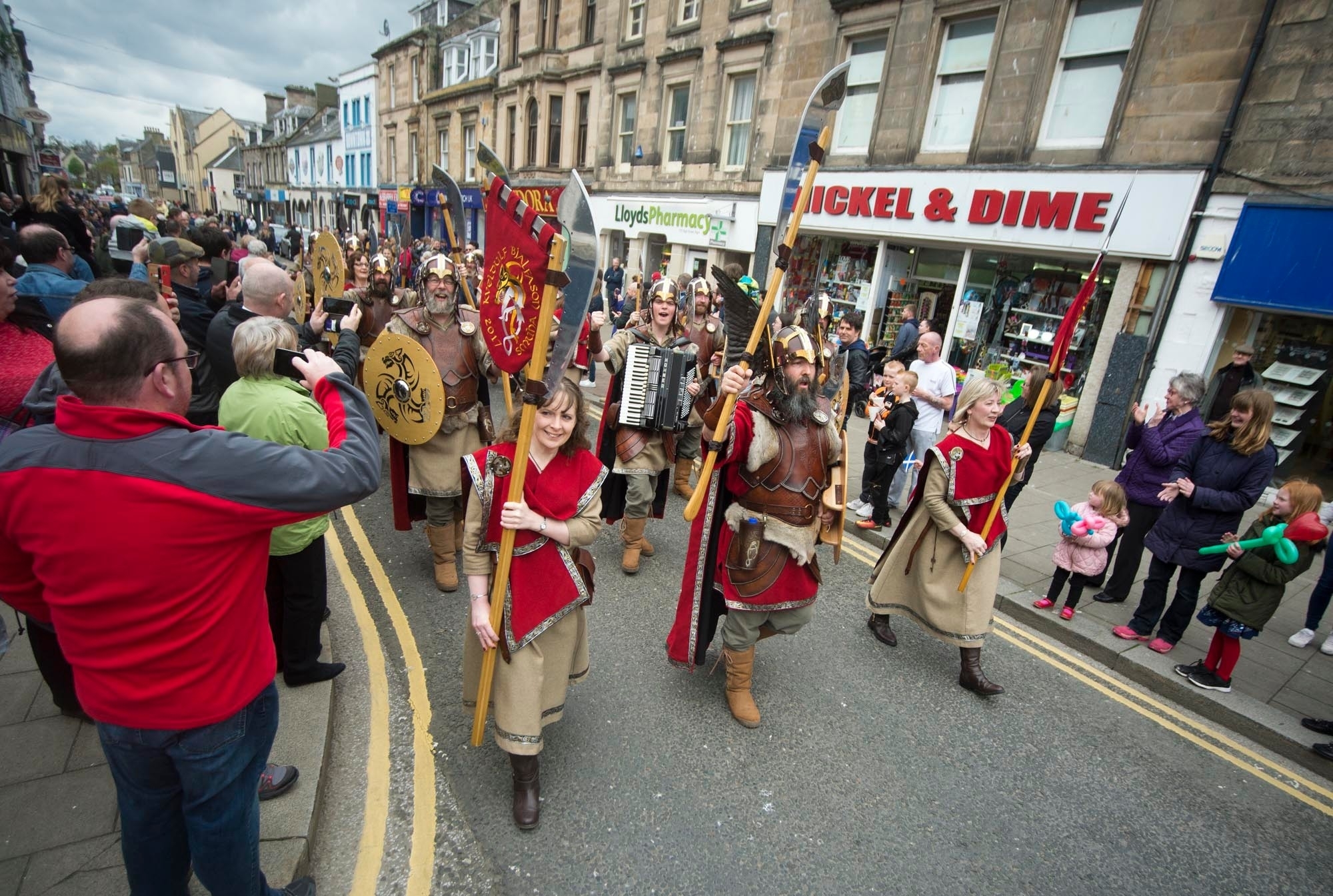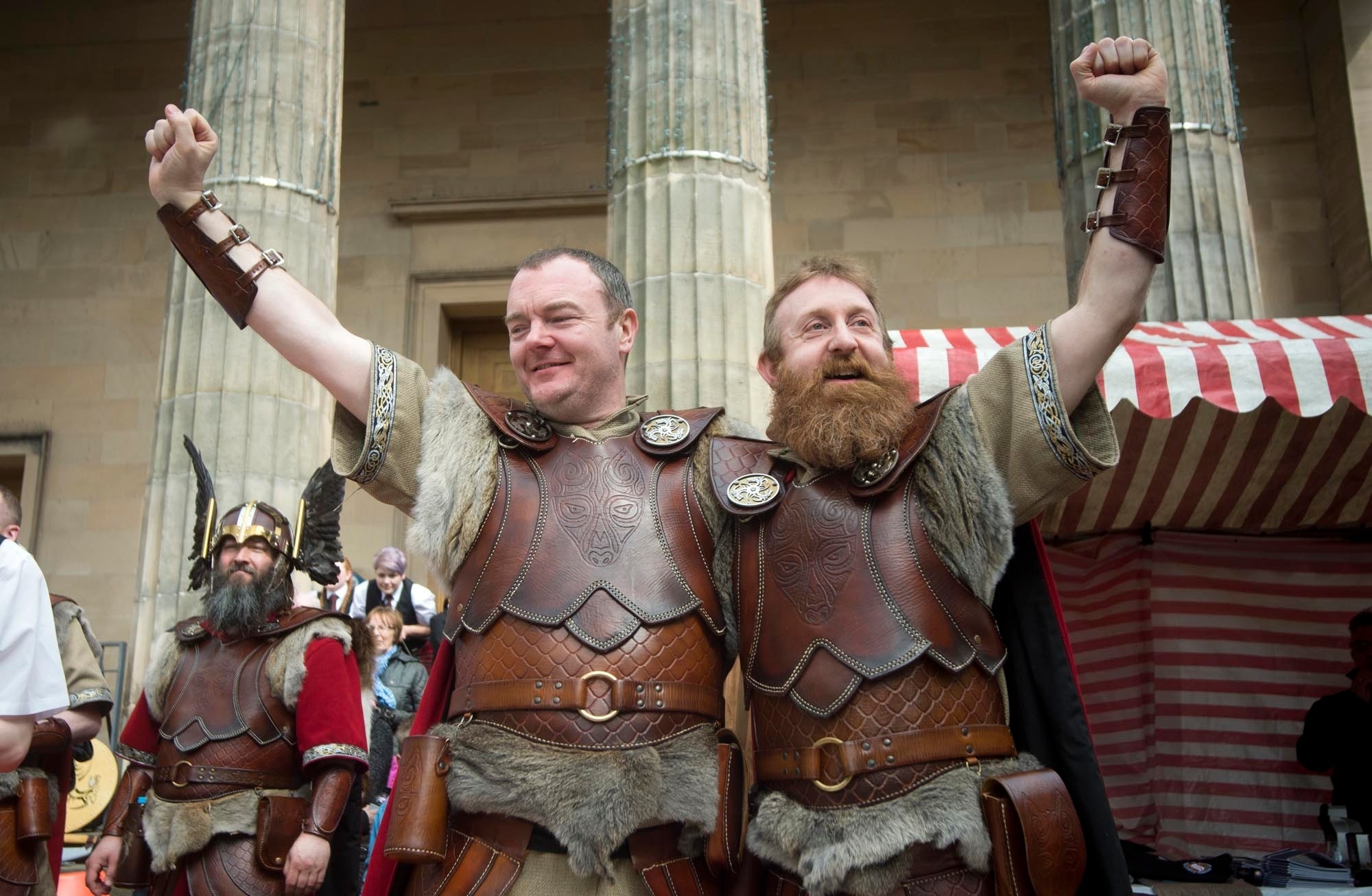Viking hordes, wielding axes and shields, marched into Moray ready for battle, and conquered all comers in a haggis-eating contest at the weekend.
The Shetland Mainland Up Helly Aa crew helped attract thousands of people into Elgin for Saturday’s Scottish Theme Day.

In one of the highlights, the Shetlanders defeated Elgin and District and Huntly and District pipe band members by scoffing platefuls of haggis more quickly than their rivals.
And, despite their fearsome costumes, the squad spent more time posing than pillaging, with excited residents requesting selfie photos “every two seconds”.
The event was staged by the Elgin Business Improvement District group and, as it drew to a close, organisers declared it had exceeded expectations.
Local drummer, Sophie Simpson, led the Viking marauders from the west of the High Street onto the Plainstones at 1pm.
The sound of the Jarl Squad’s distant cries grew louder as they marched on the centre.
They toured dozens of market stalls and several shops, letting out a series of bloodthirsty roars as they progressed.
Crowds subsequently gathered outside the St Giles Church to watch the Scottish Theme Day’s inaugural haggis-eating competition.
Two Viking teams took part in the challenge; Euan Robertson and George Roberts, and Liam Brannan and Colin Adamson.

Representing the Elgin and District Pipe Band were Ewan Syme and Christopher Hyndman, while the Huntly group put forward Peter McIntosh and David Landell.
Former president of the Elgin Burns Club, David Small, gave an animated rendition of Robert Burns’ Address to a Haggis as the competitors took their places.
After he sliced into the hefty “chieftain o’ the puddin-race”, the contest began. Under the rules, the men were not allowed to use their hands to eat the famous Scottish cuisine, and all duly plunged their faces into the steaming portions.
Shouts of “come on Elgin” from the crowd were not enough to spur the local team onto victory, as Mr Robertson and Mr Roberts polished off their helpings first.
Guizer Jarl, Brian Halcrow, is the group’s leader and arranged the trip to Elgin.
He said: “We have been stopped every two seconds for sefies, we have had a great time.
“My men were very apprehensive about the competition, so I am pleased they did us proud and won it.”
Up Helly Aa
Despite its links with ancient traditions, Up Helly Aa is a festival which sprung to life in the 19th century.
Reports from 1824 state people in Lerwick staged “uproarious” celebrations to mark Christmas Eve, with streets crammed with revellers.
As the town expanded rapidly during the 1800s, locals began to parade barrels filled with burning tar through the town.
After violence between rival groups of “tar-barrelers”, young Shetlanders decided to fashion a celebration aimed at bringing people together.
Around 1870, the inaugural Up Helly Aa took place, which delayed the celebrations until late January and incorporated a torchlight procession and “guizers”.
The Viking themes were gradually added and, in the 1880s, the original replica longship was produced.
A Guizer Jarl was first appointed to oversee the festivities in 1906 and was joined by a squad around 1920.
It gained wider fame in the 1950s, after a radio documentary – and has subsequently grown into a tourist phenomenon.
Different parts of Shetland stage their own form of the celebrations, and the South Mainland Up Helly Aa is the newest – having begun in 2010.
Guizer Jarl, Brian Halcrow, had been waiting five years for his turn to lead the festivities and oversaw the lighting of his galley in March.
The suits the men wear are all handcrafted, and represent Viking character Kveldulf Bjalfason – a figure believed to have been capable of transforming himself into a wolf.
Moray MSP, Richard Lochhead, joked that he was glad to escape his encounter with the warriors unscathed at the weekend.
He added: “I was relieved when I met the Vikings that I survived to tell the tale, they really could not have been friendlier.”